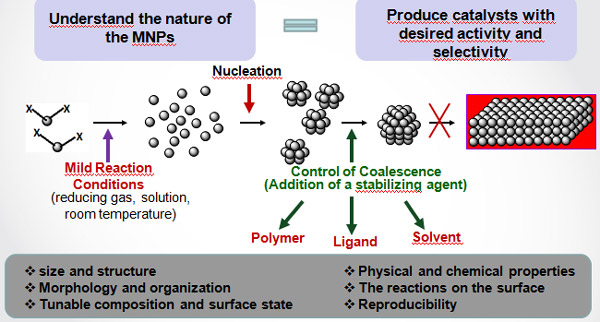MNPs) can combine both homogeneous and heterogeneous properties of catalysts: an exceptionally high surface area and a controlled surface with desired catalytic activity and selectivity. MNPs with their small size are highly interesting systems due to their high proportion of surface atoms offering numerous active sites. In addition, they have unique electronic properties at the frontier between the molecular and metallic states.
The ligands present on the surface as stabilizing agents may alter the electronic structure as well as the physical properties of the MNPs. Among many synthesis methods (e.g. pyrolysis, chemical vapor deposition, etc.), organometallic synthesis approach is very effective in achieving stable and homogeneous MNPs since the decomposition of an organometallic precursor takes place under mild conditions (low pressure reducing gas and temperature, low concentration of stabilizer etc.). For instance, platinum nanoparticles (Pt NPs) of ca. 2 nm were synthesized in CNRS at Chaudret & Philippot’s Labs with this approach by the decomposition of Pt2(dba)3and in the presence of a diphosphine ligand and either H2 or CO atmosphere.
In the last decades, fuel cells have gained increased attention as alternative electrical power sources due to their high efficiency and low pollution levels. It is an enviromentally friendly device as it operates with hydrogen; producing water as the exhaust product while generating electricity. Membrane electrode assembly, regarded as the hearth of fuel cells, consists of two gas diffusion electrodes and a proton exchange membrane in between and allows the diffusion of hydrogen as fuel and the electrochemical reaction to occur. Therefore, the production of high quality fuel cell electrodes with small and thus catalytically very active MNPs and a strong support with high surface area is essential.
Our aim in this project is to develop graphene supported mono- and bimetallic Pt NPs for developing effective and high performance fuel cell electrodes. Our efforts are towards achieving small and homogeneous MNPs and their homogeneous dispersion on the graphene support. The usage of graphene in all application fields has increased in the recent years since it is a widely investigated material with a two dimensional structure that has a very high surface area and remarkable electrical and physical properties. These properties combined with our synthesis technique for the desired metal nanoparticles will enable us achieve high performance fuel cell electrodes.
The work is supported by the Project Grant:
Development of Fuel Cell Electrodes based on Platinum Nanoparticles with Carbon Black and Graphene Support Materials, 2014-2016, supported by TUBITAK 2232 Return to Country Research Fellowship Program (PI: Solen Kinayyiğit, Academic Advisor: Selmiye Alkan Gürsel)
